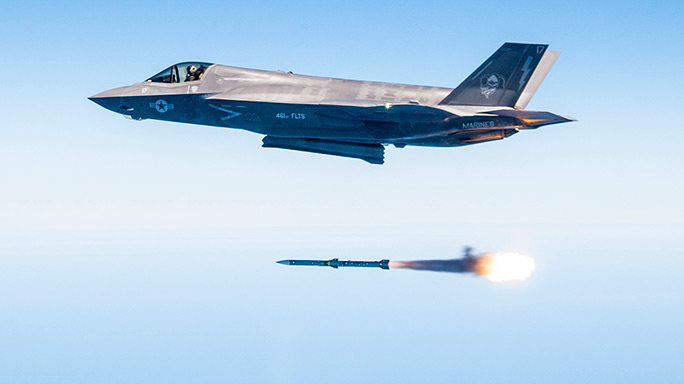The F-35 Integrated Test Force here recently completed 25 missions comprised of 12 weapons delivery accuracy and 13 weapon separation tests as part of a monthlong weapons firing test surge.
Historically, WDAs take place once a month given the myriad of coordination required. The highest number previously accomplished in a month was three in November 2014 during block 2B software testing.
- RELATED STORY: F-35A Lightning II Declared ‘Combat Ready’ by Air Force
Maj. Charles Trickey, interim director of operations for the 461st Flight Test Squadron, flew the final mission of the surge Aug. 17. The mission was completed at White Sands Missile Range, New Mexico, where F-35 Lightning IIs shot two advanced medium-range, air-to-air missiles at a QF-4 drone.
Advertisement — Continue Reading Below
“Some of these WDAs were particularly challenging events,” Trickey said. He said the final mission was actually the fourth attempt to complete this test. “It was really cool to see the satisfaction of the team, and to get that feeling of accomplishment after doing something that challenging.”
All told, the F-35 ITF deployed 30 weapons in 31 days, which included 12 WDAs and 13 separations, according to Trickey.
“Thirty separations in 31 days; that’s never been done before in flight test,” said Capt. Brett Tillman, a flight test engineer with the 461st FTS. “The fact that we could get everything together to do that number of separations in that few days is pretty amazing.”
Advertisement — Continue Reading Below
These successful test events — performed using the F-35’s newest block 3F software — demonstrated the accuracy of the aircraft. Five of the test events featured dropping multiple weapons.
The effort for this surge wasn’t limited to the F-35 test team. There were a number of units outside the F-35 ITF that put in extra effort and time to make the surge successful, including Edwards AFB airfield and tanker operations, the 416th FTS and the F-35 Joint Program Office.
The F-35 weapons test team was given exclusive use of the Sea Test Range, an instrumented Pacific Ocean test area off the central coast near Point Mugu, Calif. Tests were also conducted at the U.S. Navy’s China Lake weapons range in California and White Sands missile range.
Advertisement — Continue Reading Below
“The amount of coordination and teamwork from the ITF and the outside organizations to enable this is unprecedented,” Tillman said. “The work these team members put in is amazing. It couldn’t have been done without them.”
During this surge period, a total of 30 weapons were dropped or fired, including the joint direct attack munition, AIM-120 advanced medium-range, air-to-air missile, GPS-guided 250-pound small diameter bomb, AIM-9X Sidewinder supersonic, heat-seeking, air-to-air missile and GPS laser-guided munition.
“The WDAs rely on the full capability of the F-35 — multiple sensors, navigation, weapons envelope, mission planning, data links and inter-agency range scheduling — all working in sequence to put steel on target,” said Lt. Gen. Chris Bogdan, an F-35 program executive officer. “This was a tremendous effort by the F-35 test team. They surged and worked seven days a week for more than a month to expend 30 ordnance and advanced weapons testing. This testing has moved us that much closer to delivering the full F-35 capability to warfighters within the next two years.”
Advertisement — Continue Reading Below
The F-35 is a multi-role, next-generation fighter that combines advanced stealth with speed, agility and a 360-degree view of the battlespace. The F-35 will form the backbone of air combat superiority for decades to come and replace legacy tactical fighter fleets with dominant air-to-air and air-to-ground capabilities to deter and defeat potential adversaries.
The Marine Corps declared the F-35B combat ready, or initial operating capability, in July 2015; the Air Force declared F-35A IOC on Aug. 2; and the Navy intends to attain F-35C IOC in 2018. More than 200 F-35s have flown in excess of 66,000 fleet-wide hours, with over 300 F-35 pilots and 3,000 maintainers trained to operate and support this next-generation aircraft.
Above is a release from Christopher Ball, 412th Test Wing Public Affairs
Advertisement — Continue Reading Below























